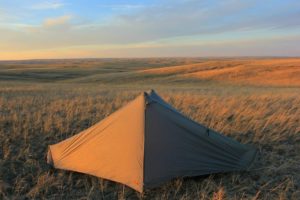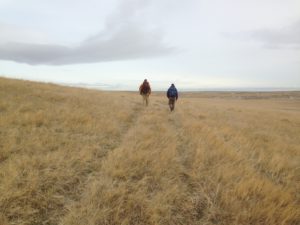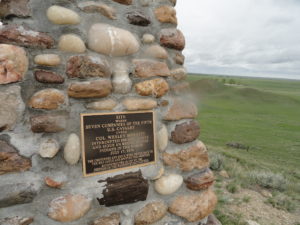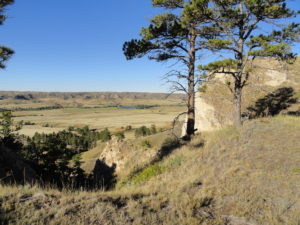From Board Member Bob Pahre:
Far from Plain
It was a photographer’s dream. Warm light streamed through the mixed prairie grasses and across our tents. The sun popped out from behind the wispy clouds with bursts of yellow, only to retreat again, leaving orange behind. As the sun settled down for the night, the oranges calmed down too. Soft pinks and then muted purples followed suit and lingered after the sun disappeared.

As night took over, we could see ranch lights turning on below. We had camped on a rise above the Nebraska-South Dakota Border, south of the Black Hills. We had seen only a few ranches when we made camp. In the dark, the lights stretched west as far as we could see, probably reaching the edge of Wyoming.
We had been scouting what has become the Pilot Trail section of the Great Plains Trail, stretching from Scotts Bluff National Monument to Bear Butte State Park. Some of our team went the distance, while I could only stay three nights. I took over from another team member, providing car shuttles and joining the hikes as I could. We had explored the route from Toadstool Geological Park to the Hudson-Meng Bison Jump on my first day. Then we searched off-trail for a way through the badlands at Toadstool, eventually finding a route that would become the first stretch of trail to have Great Plains Trail signage.

This is Northern Cheyenne territory. On my last full day, we had seen Warbonnet Hill, the site of the first military engagement after the Battle of Little Bighorn in 1876. Colonel Wesley Merritt, in command of the Fifth US Cavalry, had orders to keep the supply lines to Fort Laramie open along the Cheyenne & Black Hills Stage Road. He also wanted to keep the now-dispersed Natives from coming together into a large force again. If he could defeat them in battle, all the better.
Buffalo Bill Cody got permission to join the Fifth Cavalry for some adventure, and to add a real credential to some of the not-quite-as-real credentials he already had. When the cavalry spotted a Cheyenne force, Cody rushed to his tent and dressed in the theatrical costume he wore in his Wild West Show. I am not making this up.
Suitably costumed, Cody then joined a detachment to scout for the Cheyenne. They made contact near a small ravine here below Warbonnet Hills. Buffalo Bill and the Cheyenne leader Yellow Hair confronted each other at the front of their respective forces. Each took a shot, and Cody’s struck home. That ended the engagement. Cody collected Yellow Hair’s scalp, which he would occasionally display in the decades to come.

Like the “battle” that takes its name, Warbonnet Hill isn’t much to write home about. Other sites will catch your eye, however. Across the road you’ll find the beautiful Montrose Church on a small rise. That too is a photographer’s dream. We also saw a larger group of mule deer in the morning and a couple of unfriendly cattle in the afternoon. An abandoned schoolhouse, a large working ranch, a collapsed wooden bridge, and a variety of fences provided evidence of humans. So too did two guys in a pickup truck who asked if we were OK. They were the only people we saw that day.

The Great Plains Trail offers many of these moments, large and small, natural and historic. The hills and rises, creeks and washes continually open new vistas on a landscape that, in the words of Tony Dzik, is “Not That Flat.”

